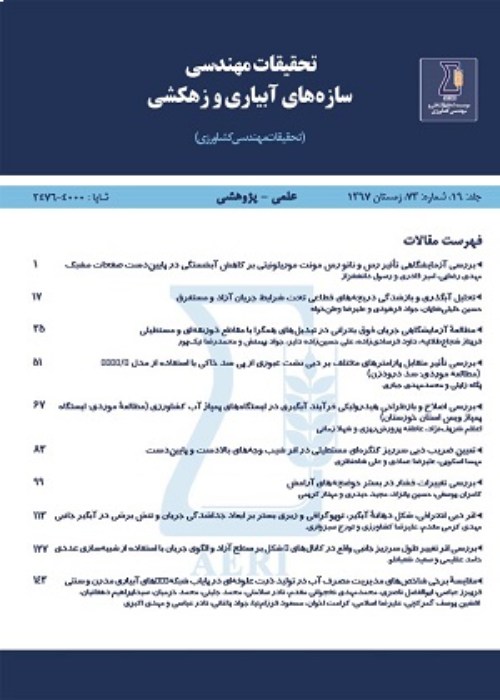An Investigation on the Application of the Kinect Device in Determining the Digital Elevation Model of Gravel Streams in Gravel Scale (Case study: Kordan Riverbed)
In recent years, the advancement of computer science helped to examine digital elevation models (DEMs) that are produced in various methods. It is possible to study DEM at different scales. These scales are: 1-fine grain scale, 2-meso scale 3-reach scale, and 4-catchment scale. Determining and studying the digital elevation model of the bed in each of these scales is important. Today, the advances achieved in computer science and its combination with engineering sciences, including river engineering, have led to new approaches in this field. One of the most widely used devices is the Kinect. The use of the Kinect for scientific purposes was first introduced in 2013 by David Monkoff as a cheap, high-precision instrument to produce three-dimensional models that could be used in a wide range of scientific studies such as geology, geomorphology and bathymetry (Mankoff & Russo, 2012). In this study, the ability of Kinect device to determine the DEM of sand bed in the Kordan River, as a method for determining the roughness of natural riverbed, has been investigated by comparing the average and relative error of DEMs prepared by Kinect and theoretical models.
In this study, the Microsoft Kinect Xbox 360 was used to produce a digital elevation model. This device costs about $100, with a frequency range of 9 to 30 Hz, the accuracy of spatial and elevation data in about a millimeter to a centimeter, and its best performance range between 50 centimeters to 5 meters. This device is capable of producing 3D information with high spatial (x, y) (2 to 20 mm) and high vertical accuracy (z) (error about 1 mm at 50 cm and error about 75 mm at 5 meters). The sensor angle of view is 57 and 43 degrees horizontal and vertical, respectively (Mankoff & Russo, 2012).The Kinect sensor is capable to capture simultaneously the color and depth images at a frame rate of more than 30 fps (30 frames per second). The incorporation of the depth and color data generates a cloud of color dots, about 300,000 dots per frame, which can consistently increase the density of dots or produce a full cloud of dots by sequential depth images. The minimum distance for Kinect is about 0.4 meters and the maximum varies between 4 to 5 meters (Khoshelham & Elbernik, 2012; Pagliari & Pinto, 2015). In this study, the kinect position was considered at 80 to 120 cm above the bed, so that all the boundaries of the bed were placed at the viewing angle of the kinect camera, achieving the lowest error rate. In order to investigate the ability of the Kinect device to determine the digital elevation model of the sandy river bed, two laboratory and field sections were defined. Two purposes of this segmentation were to compare the capability of a Kinect device in a laboratory-controlled environment with natural conditions, and to determine optimum conditions for the lab environment to be applied to the field. The results showed that the absolute error value and standard deviation related to detached cement hemispheres had been less than the figure for hemispheres joint together, however relative error was noticeably more. The results also showed that the error of the Kinect decreased with increasing size of the bed roughness elements. After having beds with regular geometric shapes been validated, the results of artificial sand beds consisting of natural aggregates with dense and non-dense arrangement were investigated. It has been observed that the error rate in the natural beds increased on average and the standard deviation of the results was twice as much as of the DEM with regular shape. It was obviously clear from the graphs that the digital elevation model developed by the Kinect device produced lower accuracy in lowlands than in upper elevations of the beds.
Having digital elevation models of artificial and natural beds been developed, the results were analyzed. At the beginning of laboratory investigations, the digital elevation model was examined on a regular basis. After beds with regular geometric shapes had been validated, the results of artificial sand beds consisting of natural aggregates with dense and non-dense arrangement were investigated.
To investigate the Kinect capability in determining the digital elevation model of sandy beds, its capability in artificial bed -consisting of small and large regular hemispheres and dense and non-dense sandstone aggregates- was first analyzed and the following results were obtained: 1. The results indicated that this device was capable to generate digital elevation models for determination of bed roughness using statistical analysis in laboratory environment. 2. Both infrared beams in outdoor spaces in sunlight and shadow in the open spaces among aggregates simply increased the error of the digital elevation model generated by the Kinect device in field studies. 3. Studies showed that the Kinect device could be a reliable replacement for outdated methods such as laser measurements and point gauges for digital elevation modeling of sand beds in laboratory.
- حق عضویت دریافتی صرف حمایت از نشریات عضو و نگهداری، تکمیل و توسعه مگیران میشود.
- پرداخت حق اشتراک و دانلود مقالات اجازه بازنشر آن در سایر رسانههای چاپی و دیجیتال را به کاربر نمیدهد.


